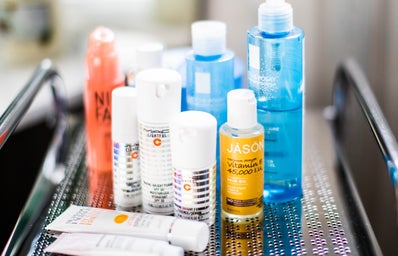When looking for beauty products, you might see labels like “sulfate-free” or “paraben-free.” What does that mean? What are sulfates? What are parabens? Why are some shampoos gluten-free? Is gluten needed in soap?!
Sulfates are something called “surfactants,” which are used to reduce surface tension between liquids and solids. Sodium lauryl sulfate and sodium laureth sulfate (SLS) is the commonly used surfactant. Why? It’s cheap. That’s why they are used so much for day to day items such as detergents, emulsifiers and foaming agent. Also, it’s used to clean car engines. The common perception is that when you’re trying to get clean (shampoo, face wash, body soap), the foam means it’s working. In actuality, the foaming is just for aesthetics. Why is it so bad? SLS is a carcinogen that doesn’t degrade easily and stays in the environment for a long time, even when it’s washed down the drain. It ends up in marine environments and becomes toxic to aquatic animals. On humans, SLS strips the natural oils in the skin which causes severe dryness and skin irritation. If you’ve ever wondered why you seem to never get rid of your dandruff or dry skin, check the label on your product and check if sodium lauryl sulfate is one of the main ingredients.
Parabens are another common additive used in household cleaners and beauty products to act as a preservative and bacteria preventative. This includes mostly methylparaben and butylparaben. They can not natural and can cause a multitude of reactions, especially to those who have sensitive skin. The reason parabens are so bad is because they are known to disrupt hormone function that leads to an increased risk of breast cancer and reproductive toxicity. Parabens mimic estrogen by binding to estrogen receptors in cells and can penetrate the skin and remain in the tissue. When they are washed into lakes and rivers, the parabens lock onto estrogen in fish and disrupt their hormones, making them reproductively sterile or causing tissue damage.
Other things to watch out for are silicones like dimethicone (things that end in -cone, -conol, -siloxane) which are used to give products a silky, spreadable texture. They can be harmful to the environment; in humans they can clog and dehydrate your skin! Mineral oils are mixed into a lot of moisturizers but can clog the pores in your face.
Now, you may be wondering, “Then what can I do?! I just want good, clean skin!” Look for labels on products that say “paraben-free”, “SLS free”, or “silicone free.” If the item says it’s all natural, look on the back to see if they really are using natural ingredients or go online if the information is unavailable. Cheap additives and shiny packaging won’t do the work you want done. Get products with real ingredients (tea tree oil, witch hazel, honey, vitamin C) from companies who care about the ecosystem and what goes both on and into your body. There are eco-friendlier, skin-friendlier alternatives! Sodium cocoyl isethionate is coconut derived surfactant that’s gentle and environmentally friendly. Glycerin is a great, plant derived humectant (moisturizer) that’ll keep your skin plump and hydrated. Cetyl and Stearyl alcohol both thicken creams and are GREAT for dry skin. So next time you’re in Target looking for your holy grail product, check the labels and get skin that’s both good for you and the environment.


